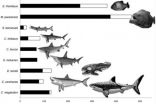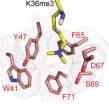New technique catalogs lymphoma-linked genetic variations
2012-12-27
(Press-News.org) As anyone familiar with the X-Men knows, mutants can be either very good or very bad — or somewhere in between. The same appears true within cancer cells, which may harbor hundreds of mutations that set them apart from other cells in the body; the scientific challenge has been to figure out which mutations are culprits and which are innocent bystanders. Now, researchers at Johns Hopkins Medicine have devised a novel approach to sorting them out: they generated random mutations in a gene associated with lymphoma, tested the proteins produced by the genes to see how they performed, and generated a catalog of mutants with cancer-causing potential.
"Our goal was to correlate various mutations with potential to promote lymphoma," says Joel Pomerantz, Ph.D., an associate professor in the Johns Hopkins School of Medicine's Institute for Cell Engineering. For the study, to be reported in a January 2013 issue of Molecular and Cellular Biology, Pomerantz and his research team focused on the protein CARD11. CARD11 plays a key role in signaling the presence of infection, which leads infection-fighting white blood cells to grow and divide. Certain mutations can turn CARD11 permanently "on," causing out-of-control cell division that results in cancers called lymphomas, which strike about 75,000 Americans each year.
To find out which genetic mutations would increase CARD11's activity, Pomerantz and his team made copies of the CARD11 gene in a way that made random mutations likely. They then used the faulty copies to make mutant proteins, and tested the ability of those proteins to trigger the signaling reaction that is CARD11's specialty. This let the researchers figure out which mutations increased the protein's activity, and by how much — information that can be compared to emerging data about CARD11 mutations found in human lymphomas. "We found that several of the overactive mutations we'd identified have already been found in patients," Pomerantz says.
Noting that CARD11 is part of the NF-κB signaling pathway, a target of some cancer therapies, Pomerantz says the new cataloging technique could lead to more personalized treatment. "We imagine eventually being able to correlate response to a particular therapy with a particular mutation," he says. For now, Pomerantz and his team are delving deeper into what gives the bad CARD11 mutants their special powers, looking for mechanisms to explain how certain changes increase the protein's activity.
###
Other authors on the paper are Waipan Chan and Thomas B. Schaffer, both of the Johns Hopkins University School of Medicine.
The study was funded by the National Institutes of Health (grant numbers RO1AI078980 and PO1AI072677), the American Cancer Society (grant number RSG-06-172-01-LIB) and the Johns Hopkins Institute for Cell Engineering. END
ELSE PRESS RELEASES FROM THIS DATE:
2012-12-27
ROCHESTER, Minn. -- For nearly a decade, breast cancer researchers studying the hormone therapy tamoxifen have been divided as to whether genetic differences in a liver enzyme affect the drug's effectiveness and the likelihood breast cancer will recur. A new study by researchers from the Mayo Clinic Cancer Center and the Austrian Breast and Colorectal Cancer Study Group provides evidence that genetic differences in the enzyme CYP2D6 play a key role in how well tamoxifen works.
"Our findings confirm that, in early breast cancer treated with tamoxifen, genetic alterations ...
2012-12-27
PHILADELPHIA – Nearly half of the 700,000 cancer patients who undergo surgical removal of a primary tumor each year suffer a recurrence of their disease at some point, and many of those patients will eventually die from their disease. The traditional view of recurrent tumors is that they are resistant to therapy because they've acquired additional genetic mutations that make them more aggressive and impervious to drugs. Now, however, researchers at the Perelman School of Medicine at the University of Pennsylvania show in an animal model that the enhanced aggressiveness ...
2012-12-27
Taking into consideration its size, an ancient relative of piranhas weighing about 20 pounds delivered a bite with a force more fierce than prehistoric whale-eating sharks, the four-ton ocean-dwelling Dunkleosteus terrelli and – even – Tyrannosaurus rex.
Besides the force of the bite, Megapiranha paranensis appears to have had teeth capable of shearing through soft tissue the way today's piranhas do, while also being able to pierce thick shells and crack armoring and bones, according to Stephanie Crofts, a University of Washington doctoral student in biology.
"If our ...
2012-12-27
Many of the most common inpatient surgeries in the United States are performed electively. These surgeries are expected to significantly increase with the enactment of the Affordable Care Act. In a new perspectives article, published in the Dec. 27 edition of The New England Journal of Medicine, a team of Weill Cornell Medical College researchers are recommending the nation's health care leaders and medical community join forces to establish evidence-based appropriateness criteria to determine which patients are most in need of elective procedures, such as joint replacement ...
2012-12-27
CHAPEL HILL - Long-standing research efforts have been focused on understanding how stem cells, cells capable of transforming into any type of cell in the body, are capable of being programmed down a defined path to contribute to the development of a specific organ like a heart, lung, or kidney. Research from the University of North Carolina at Chapel Hill School of Medicine has shed new light on how epigenetic signals may function together to determine the ultimate fate of a stem cell.
The study, published December 27, 2012 by the journal Molecular Cell, implicates ...
2012-12-27
Congenital hyperinsulinism is a genetic condition where a baby's pancreas secretes too much insulin. It affects approximately one in 50,000 live births and in severe cases requires the surgical removal of all or part of the pancreas.
Researchers at the University of Exeter Medical School are the first in the world to utilise new genetic sequencing technology to sequence the entirety of a gene in order to identify mutations that cause hyperinsulinism. Previously, existing technology limited such sequencing to only part of the coding regions of the gene which meant that ...
2012-12-27
Researchers at McGill University have discovered that a key regulator of energy metabolism in cancer cells known as the AMP-activated protein kinase (AMPK) may play a crucial role in restricting cancer cell growth. AMPK acts as a "fuel gauge" in cells; AMPK is turned on when it senses changes in energy levels, and helps to change metabolism when energy levels are low, such as during exercise or when fasting. The researchers found that AMPK also regulates cancer cell metabolism and can restrict cancer cell growth.
The discovery was made by Russell (Rusty) Jones, an assistant ...
2012-12-27
KANSAS CITY, MO—Unlike less versatile muscle or nerve cells, embryonic stem cells are by definition equipped to assume any cellular role. Scientists call this flexibility "pluripotency," meaning that as an organism develops, stem cells must be ready at a moment's notice to activate highly diverse gene expression programs used to turn them into blood, brain, or kidney cells.
Scientists from the lab of Stowers Investigator Ali Shilatifard, Ph.D., report in the December 27, 2012 online issue of Cell that one way cells stay so plastic is by stationing a protein called Ell3 ...
2012-12-27
In the period just before they went extinct, the American lions and saber-toothed cats that roamed North America in the late Pleistocene were living well off the fat of the land.
That is the conclusion of the latest study of the microscopic wear patterns on the teeth of these great cats recovered from the La Brea tar pits in southern California. Contrary to previous studies, the analysis did not find any indications that the giant carnivores were having increased trouble finding prey in the period before they went extinct 12,000 years ago.
The results, published on ...
2012-12-27
PHILADELPHIA - When trying to determine the root cause of a person's dementia, using an MRI can effectively and non-invasively screen patients for Alzheimer's disease or Frontotemporal Lobar Degeneration (FTLD), according to a new study by researchers from the Perelman School of Medicine at the University of Pennsylvania. Using an MRI-based algorithm effectively differentiated cases 75 percent of the time, according to the study, published in the December 26th, 2012, issue of Neurology®, the medical journal of the American Academy of Neurology. The non-invasive approach ...
LAST 30 PRESS RELEASES:
[Press-News.org] New technique catalogs lymphoma-linked genetic variations



